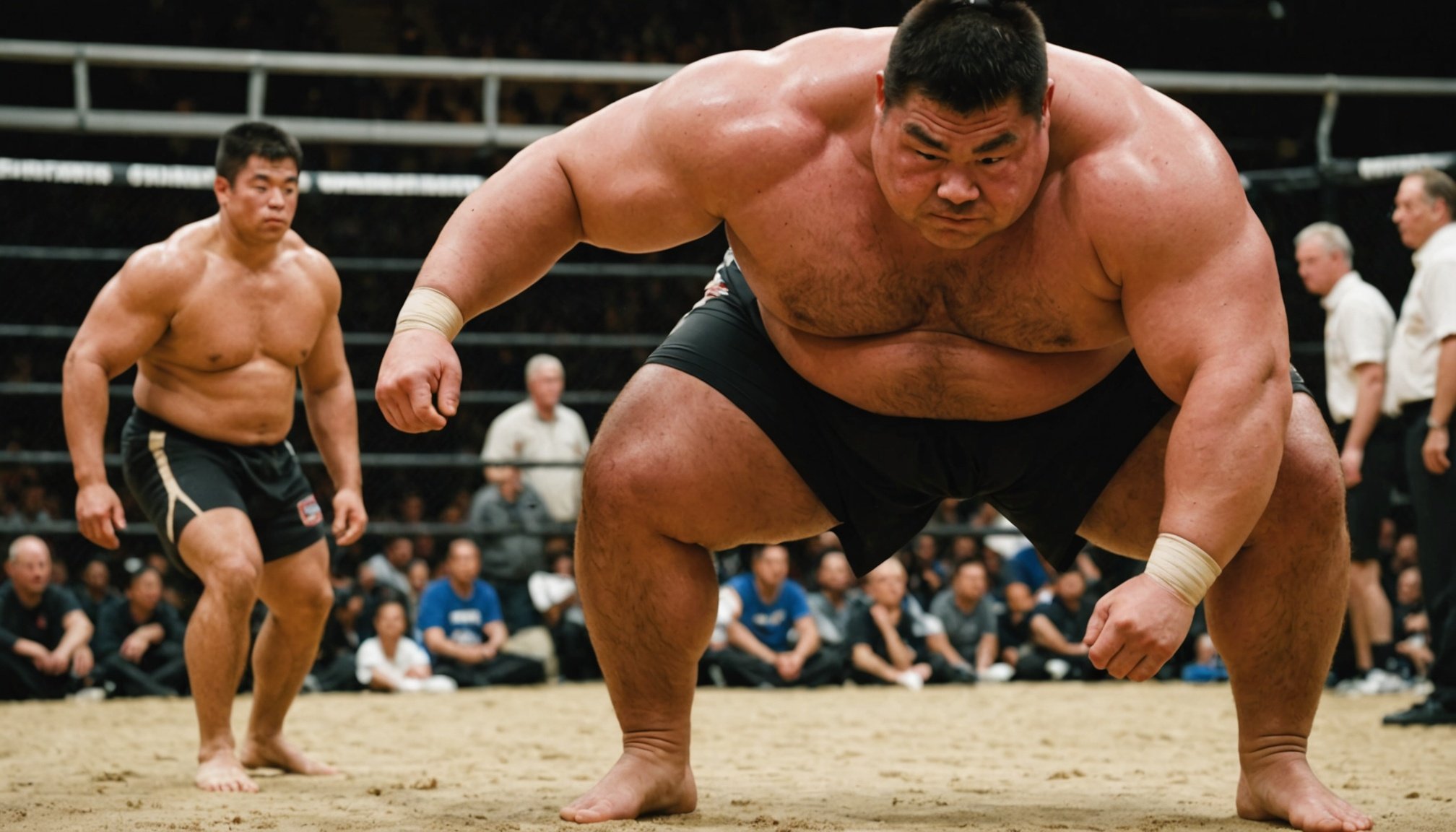Ultimate Guide to Elevating Performance: Weight Training Strategies for UK Sumo Wrestlers
Understanding the Demands of Sumo Wrestling
Sumo wrestling, a martial art with a 1,500-year history, is not just about size and strength; it requires a meticulous balance of power, agility, and technique. For UK sumo wrestlers aiming to elevate their performance, understanding the specific demands of the sport is crucial. Sumo wrestlers, or rikishi, need to maintain a high caloric intake, often between 4,000 and 10,000 calories per day, which includes a diet rich in rice and sometimes supplemented with beer to boost their energy levels[1].
Building the Foundation: Strength Training
Strength training is the backbone of any sumo wrestler’s training program. Here are some key components to focus on:
Also to read : Conquering competition day: effective stress relief techniques for uk taekwondo competitors
Lower Body Strength
The lower body is critical in sumo wrestling, as it provides the base for stability, power, and movement. Exercises such as the sumo squat and deadlift are essential.
-
Sumo Squat: This variation of the squat involves a wider stance, which targets the thigh muscles, particularly the inner thighs. It mimics the stance sumo wrestlers use in the ring and helps in developing the necessary strength and flexibility.
Also read : Unlocking the art of sweeps: key strategies for uk sanda practitioners to enhance their skills
-
How to Perform: Stand with your feet wider than shoulder-width apart, toes pointing outward. Lower your body down into a squat, keeping your back straight and your knees in line with your toes. Push through your heels to return to the starting position.
-
Benefits: Enhances force production, improves range of motion, and strengthens the lower body.
-
Deadlift: Deadlifts are a powerlifting staple that work multiple muscle groups simultaneously, including the lower back, glutes, and legs.
-
How to Perform: Stand over a barbell with your feet shoulder-width apart. Bend down and grasp the bar with an overhand grip, keeping your back straight and your core engaged. Lift the bar up to hip level, then lower it back down to the starting position.
-
Benefits: Increases overall strength, improves grip strength, and enhances muscle mass.
Upper Body Strength
While the lower body is paramount, upper body strength is also vital for sumo wrestlers. Here are some key exercises:
-
Bench Press: This exercise targets the chest, shoulders, and triceps.
-
How to Perform: Lie on a flat bench and grip the barbell with your hands slightly wider than shoulder-width apart. Lower the bar to your chest, then press it back up to the starting position.
-
Benefits: Enhances upper body strength, improves overall muscle mass.
-
Grip Strength Exercises: Grip strength is crucial for sumo wrestlers as it affects their ability to grasp and hold their opponent.
-
How to Perform: Use grip strengtheners or perform exercises like the farmer’s walk, where you hold heavy weights in each hand and walk for a set distance.
-
Benefits: Improves grip strength, enhances overall hand and forearm strength.
Flexibility and Mobility
Flexibility and mobility are often overlooked but are critical for sumo wrestlers. Here’s why:
Importance of Flexibility
Flexibility allows sumo wrestlers to maintain a wide stance and move efficiently around the ring. Here are some strategies to improve flexibility:
-
Static Stretching: Focus on stretches that target the lower body, such as the hamstrings, quadriceps, and hip flexors.
-
Example: Stand with your feet shoulder-width apart and lean forward to stretch your hamstrings.
-
Benefits: Improves range of motion, reduces injury risk.
-
Dynamic Stretching: Incorporate dynamic stretches into your warm-up routine to prepare your muscles for the upcoming exercise.
-
Example: Leg swings, lunges, and high knees.
-
Benefits: Enhances blood flow, prepares muscles for intense activity.
Specific Sumo Drills and Training
In addition to general strength and flexibility training, sumo wrestlers need to practice specific drills that mimic the movements and techniques used in the ring.
Tachiai Training
The tachiai is the initial charge in sumo wrestling, a critical moment that sets the tone for the match. Here are some strategies to elevate your tachiai technique:
- Proper Stance: Maintain a wide stance with your feet pointing outward, similar to the sumo squat stance.
- Benefits: Provides stability, allows for powerful forward movement.
- Core Engagement: Keep your core muscles engaged to generate force and maintain balance.
- Benefits: Enhances force production, improves stability.
- Arm Positioning: Keep your arms low and ready to engage with your opponent.
- Benefits: Allows for quick reaction, improves grip strength.
Sample Training Program
Here is a sample training program that incorporates the strategies mentioned above:
Monday (Lower Body Strength)
- Sumo Squats: 3 sets of 8-12 reps
- Deadlifts: 3 sets of 6-8 reps
- Leg Press: 3 sets of 10-12 reps
- Calf Raises: 3 sets of 12-15 reps
Tuesday (Upper Body Strength)
- Bench Press: 3 sets of 8-12 reps
- Incline Dumbbell Press: 3 sets of 10-12 reps
- Bent Over Rows: 3 sets of 8-12 reps
- Grip Strength Exercises: 3 sets of 10-12 reps
Wednesday (Rest Day)
Thursday (Lower Body Strength)
- Sumo Squats: 3 sets of 8-12 reps
- Romanian Deadlifts: 3 sets of 6-8 reps
- Lunges: 3 sets of 10-12 reps per leg
- Leg Extensions: 3 sets of 12-15 reps
Friday (Upper Body Strength)
- Pull-ups: 3 sets of as many reps as possible
- Dumbbell Shoulder Press: 3 sets of 10-12 reps
- Bicep Curls: 3 sets of 12-15 reps
- Tricep Dips: 3 sets of 12-15 reps
Saturday and Sunday (Rest Days or Active Recovery)
Practical Insights and Actionable Advice
Use of Equipment
- Knee Sleeves: Use knee sleeves during squats and deadlifts to provide support and stability.
- Benefits: Reduces injury risk, enhances performance.
- Weightlifting Belts: Use weightlifting belts to support your lower back during heavy lifts.
- Benefits: Reduces injury risk, enhances force production.
Nutrition and Recovery
- High Caloric Intake: Ensure you are consuming enough calories to support muscle growth and recovery.
- Example: Aim for a diet rich in protein, carbohydrates, and healthy fats.
- Benefits: Supports muscle growth, enhances recovery.
- Adequate Rest: Ensure you are getting enough rest and recovery time between training sessions.
- Benefits: Enhances muscle recovery, reduces injury risk.
Quotes and Anecdotes
-
“I’ve only seen it on the television and the internet, it’s very new to me and impressive,” says Fukutsuumi Akira, a sumo wrestler who recently promoted sumo’s return to the Royal Albert Hall. This highlights the growing interest and need for structured training programs for UK sumo wrestlers[1].
-
“The command the wrestlers have over their enormous frames is immediately obvious,” notes a journalist who attempted sumo wrestling. This underscores the importance of strength, flexibility, and technique in sumo wrestling[1].
Detailed Bullet Point List: Key Exercises for Sumo Wrestlers
-
Sumo Squats
-
Targets: Thigh muscles, glutes, lower back
-
Benefits: Enhances force production, improves range of motion
-
How to Perform: Stand with feet wider than shoulder-width apart, toes pointing outward. Lower body down into a squat, keeping back straight and knees in line with toes.
-
Deadlifts
-
Targets: Lower back, glutes, legs
-
Benefits: Increases overall strength, improves grip strength
-
How to Perform: Stand over a barbell with feet shoulder-width apart. Bend down and grasp the bar with an overhand grip, keeping back straight and core engaged. Lift the bar up to hip level, then lower it back down.
-
Bench Press
-
Targets: Chest, shoulders, triceps
-
Benefits: Enhances upper body strength, improves overall muscle mass
-
How to Perform: Lie on a flat bench and grip the barbell with hands slightly wider than shoulder-width apart. Lower the bar to your chest, then press it back up to the starting position.
-
Grip Strength Exercises
-
Targets: Hands, forearms
-
Benefits: Improves grip strength, enhances overall hand and forearm strength
-
How to Perform: Use grip strengtheners or perform exercises like the farmer’s walk.
-
Leg Press
-
Targets: Thigh muscles, glutes
-
Benefits: Enhances lower body strength, reduces strain on the back
-
How to Perform: Sit in a leg press machine and push the platform away from you with your feet.
-
Romanian Deadlifts
-
Targets: Lower back, glutes, hamstrings
-
Benefits: Enhances lower body strength, improves flexibility
-
How to Perform: Stand over a barbell with feet shoulder-width apart. Bend down and grasp the bar with an overhand grip, keeping back straight and core engaged. Lift the bar up to just below the knees, then lower it back down.
Comprehensive Table: Comparison of Key Exercises
| Exercise | Targets | Benefits | How to Perform |
|---|---|---|---|
| Sumo Squats | Thigh muscles, glutes, lower back | Enhances force production, improves range of motion | Stand with feet wider than shoulder-width apart, toes pointing outward. Lower body down into a squat. |
| Deadlifts | Lower back, glutes, legs | Increases overall strength, improves grip strength | Stand over a barbell with feet shoulder-width apart. Bend down and grasp the bar with an overhand grip. |
| Bench Press | Chest, shoulders, triceps | Enhances upper body strength, improves overall muscle mass | Lie on a flat bench and grip the barbell with hands slightly wider than shoulder-width apart. |
| Grip Strength Exercises | Hands, forearms | Improves grip strength, enhances overall hand and forearm strength | Use grip strengtheners or perform exercises like the farmer’s walk. |
| Leg Press | Thigh muscles, glutes | Enhances lower body strength, reduces strain on the back | Sit in a leg press machine and push the platform away from you with your feet. |
| Romanian Deadlifts | Lower back, glutes, hamstrings | Enhances lower body strength, improves flexibility | Stand over a barbell with feet shoulder-width apart. Bend down and grasp the bar with an overhand grip. |
In conclusion, elevating performance in sumo wrestling requires a holistic approach that includes strength training, flexibility and mobility exercises, and specific sumo drills. By focusing on these key areas and incorporating the right exercises into your training program, UK sumo wrestlers can significantly improve their strength, technique, and overall performance in the ring. Remember, consistency, patience, and the right guidance are key to achieving success in this demanding yet rewarding martial art.











